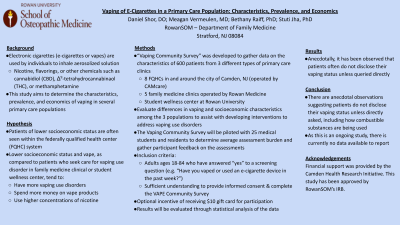Back

Clinical: General Topics
Vaping of E-Cigarettes in a Primary Care Population: Characteristics, Prevalence, and Economics
Friday, March 31, 2023
12:00 PM East Coast USA Time

- DS
Daniel Shor, DO
Rowan University School of Osteopathic Medicine
Voorhees, New Jersey, United States
Presenting Author(s)
Background and Hypothesis: Electronic cigarettes, also known as e-cigarettes or vapes, are battery-operated devices from which individuals inhale an aerosolized solution (a process called vaping), which typically may contain a variety of substances, including nicotine, flavorings, or other chemicals such as cannabidiol (CBD), Δ9-tetrahydrocannabinaol (THC), or methamphetamine. This study aims to determine the characteristics, prevalence, and economics of vaping in several primary care populations. This project is designed to determine if there are differences in vaping characteristics (including types of substances being vaped) as well as socioeconomic characteristics while gathering participant feedback on these assessments amongst 3 varied populations of patients. The ultimate goal of the project is developing and prioritizing interventions based on this data to address vaping use disorders.
We hypothesized that patients of lower socioeconomic status, who often face a multitude of barriers to accessing healthcare and are commonly seen within federally qualified health centers (FQHC), will have more vaping use disorders, spend more money on vape products, and use higher concentrations of nicotine in their vaping solutions compared to patients who vape that seek professional care for their vaping use disorder in an outpatient family medicine clinic or student wellness center.
Methods: A vaping assessment called the “Vaping Community Survey” was developed to gather data on the characteristics of 600 patients over 2 years within 12 clinics in New Jersey. These sites include CamCARE, a FQHC serving six locations in and around the city of Camden, NJ, the 5 offices of Rowan Family Medicine (which provide outpatient care across 4 counties in Southern New Jersey), and the Student Health Center at Rowan University, Glassboro. The IRB approved Vaping Community Survey is deployed by research assistants included as personnel in the IRB. Inclusion criteria for participants will be males and females ages 18-84 who have answered “yes” to a screening question (e.g. “Have you vaped or used an e-cigarette device in the past week?”) and have sufficient understanding, based on their answers to the consent quiz, to complete the VAPE Community Survey to provide informed consent. Subjects are given the option of receiving a $10 gift card for participating in the survey.
Results: The results of the VAPE Project will be evaluated through statistical analysis of the data collected. As the project is ongoing, data is currently being gathered with the plan of obtaining the results by Spring 2023.
Conclusion: Pending data collection and analysis.
Acknowledgement of Research Study Sponsors and IRB: Financial support was provided by the Camden Health Research Initiative. This study has been approved by RowanSOM’s IRB.
We hypothesized that patients of lower socioeconomic status, who often face a multitude of barriers to accessing healthcare and are commonly seen within federally qualified health centers (FQHC), will have more vaping use disorders, spend more money on vape products, and use higher concentrations of nicotine in their vaping solutions compared to patients who vape that seek professional care for their vaping use disorder in an outpatient family medicine clinic or student wellness center.
Methods: A vaping assessment called the “Vaping Community Survey” was developed to gather data on the characteristics of 600 patients over 2 years within 12 clinics in New Jersey. These sites include CamCARE, a FQHC serving six locations in and around the city of Camden, NJ, the 5 offices of Rowan Family Medicine (which provide outpatient care across 4 counties in Southern New Jersey), and the Student Health Center at Rowan University, Glassboro. The IRB approved Vaping Community Survey is deployed by research assistants included as personnel in the IRB. Inclusion criteria for participants will be males and females ages 18-84 who have answered “yes” to a screening question (e.g. “Have you vaped or used an e-cigarette device in the past week?”) and have sufficient understanding, based on their answers to the consent quiz, to complete the VAPE Community Survey to provide informed consent. Subjects are given the option of receiving a $10 gift card for participating in the survey.
Results: The results of the VAPE Project will be evaluated through statistical analysis of the data collected. As the project is ongoing, data is currently being gathered with the plan of obtaining the results by Spring 2023.
Conclusion: Pending data collection and analysis.
Acknowledgement of Research Study Sponsors and IRB: Financial support was provided by the Camden Health Research Initiative. This study has been approved by RowanSOM’s IRB.
